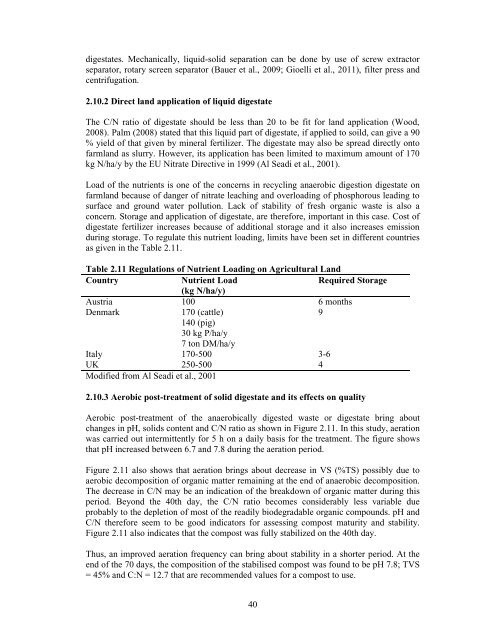dry anaerobic digestion of municipal solid waste and digestate ...
dry anaerobic digestion of municipal solid waste and digestate ...
dry anaerobic digestion of municipal solid waste and digestate ...
Create successful ePaper yourself
Turn your PDF publications into a flip-book with our unique Google optimized e-Paper software.
<strong>digestate</strong>s. Mechanically, liquid-<strong>solid</strong> separation can be done by use <strong>of</strong> screw extractor<br />
separator, rotary screen separator (Bauer et al., 2009; Gioelli et al., 2011), filter press <strong>and</strong><br />
centrifugation.<br />
2.10.2 Direct l<strong>and</strong> application <strong>of</strong> liquid <strong>digestate</strong><br />
The C/N ratio <strong>of</strong> <strong>digestate</strong> should be less than 20 to be fit for l<strong>and</strong> application (Wood,<br />
2008). Palm (2008) stated that this liquid part <strong>of</strong> <strong>digestate</strong>, if applied to soild, can give a 90<br />
% yield <strong>of</strong> that given by mineral fertilizer. The <strong>digestate</strong> may also be spread directly onto<br />
farml<strong>and</strong> as slurry. However, its application has been limited to maximum amount <strong>of</strong> 170<br />
kg N/ha/y by the EU Nitrate Directive in 1999 (Al Seadi et al., 2001).<br />
Load <strong>of</strong> the nutrients is one <strong>of</strong> the concerns in recycling <strong>anaerobic</strong> <strong>digestion</strong> <strong>digestate</strong> on<br />
farml<strong>and</strong> because <strong>of</strong> danger <strong>of</strong> nitrate leaching <strong>and</strong> overloading <strong>of</strong> phosphorous leading to<br />
surface <strong>and</strong> ground water pollution. Lack <strong>of</strong> stability <strong>of</strong> fresh organic <strong>waste</strong> is also a<br />
concern. Storage <strong>and</strong> application <strong>of</strong> <strong>digestate</strong>, are therefore, important in this case. Cost <strong>of</strong><br />
<strong>digestate</strong> fertilizer increases because <strong>of</strong> additional storage <strong>and</strong> it also increases emission<br />
during storage. To regulate this nutrient loading, limits have been set in different countries<br />
as given in the Table 2.11.<br />
Table 2.11 Regulations <strong>of</strong> Nutrient Loading on Agricultural L<strong>and</strong><br />
Country Nutrient Load<br />
(kg N/ha/y)<br />
Required Storage<br />
Austria 100 6 months<br />
Denmark 170 (cattle)<br />
140 (pig)<br />
30 kg P/ha/y<br />
7 ton DM/ha/y<br />
9<br />
Italy 170-500 3-6<br />
UK 250-500 4<br />
Modified from Al Seadi et al., 2001<br />
2.10.3 Aerobic post-treatment <strong>of</strong> <strong>solid</strong> <strong>digestate</strong> <strong>and</strong> its effects on quality<br />
Aerobic post-treatment <strong>of</strong> the <strong>anaerobic</strong>ally digested <strong>waste</strong> or <strong>digestate</strong> bring about<br />
changes in pH, <strong>solid</strong>s content <strong>and</strong> C/N ratio as shown in Figure 2.11. In this study, aeration<br />
was carried out intermittently for 5 h on a daily basis for the treatment. The figure shows<br />
that pH increased between 6.7 <strong>and</strong> 7.8 during the aeration period.<br />
Figure 2.11 also shows that aeration brings about decrease in VS (%TS) possibly due to<br />
aerobic decomposition <strong>of</strong> organic matter remaining at the end <strong>of</strong> <strong>anaerobic</strong> decomposition.<br />
The decrease in C/N may be an indication <strong>of</strong> the breakdown <strong>of</strong> organic matter during this<br />
period. Beyond the 40th day, the C/N ratio becomes considerably less variable due<br />
probably to the depletion <strong>of</strong> most <strong>of</strong> the readily biodegradable organic compounds. pH <strong>and</strong><br />
C/N therefore seem to be good indicators for assessing compost maturity <strong>and</strong> stability.<br />
Figure 2.11 also indicates that the compost was fully stabilized on the 40th day.<br />
Thus, an improved aeration frequency can bring about stability in a shorter period. At the<br />
end <strong>of</strong> the 70 days, the composition <strong>of</strong> the stabilised compost was found to be pH 7.8; TVS<br />
= 45% <strong>and</strong> C:N = 12.7 that are recommended values for a compost to use.<br />
40

















